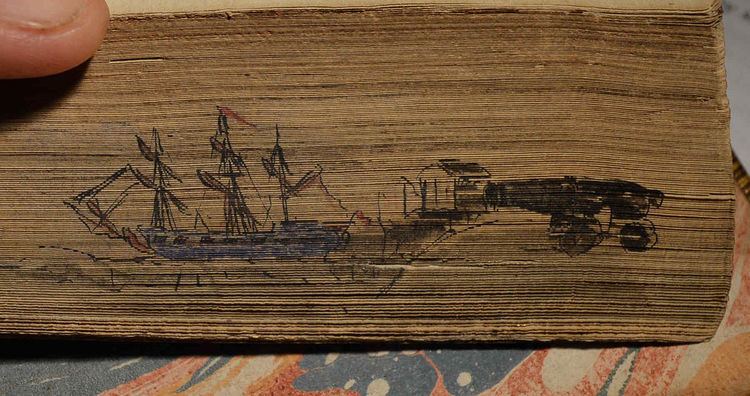Name Earl of Abergavenny Ordered 5 December 1787 Construction started 8 March 1788 Length 49 m | Namesake Earl of Abergavenny Laid down 8 March 1788 Launched 24 August 1789 Builder Northfleet | |
 | ||
Owner William Dent (principal managing owner) Fate Sold to the Royal Navy in 1795 | ||
HMS Abergavenny was originally the Earl of Abergavenny, an East Indiaman sailing for the British East India Company (EIC). As an East Indiaman she made two trips to China between 1790 and 1794. The Royal Navy bought her in 1795, converted her to a 56-gun fourth-rate ship of the line, and renamed her. One year later the East India Company built a new and much larger ship which was also named the Earl of Abergavenny and which sank off Weymouth Bay in 1805. HMS Abergavenny was sold for breaking in 1807.
Contents
East India Company
Captain John Wordsworth completed two return voyages to China and back between January 1790 and September 1794.
On her first voyage Earl of Abergavenny departed the Downs on 30 January 1790, arriving Bombay, India on 5 June 1790. She left there on 8 August arrived in Penang on 25 August. She reached Whampoa on 3 October. For her return she crossed Second Bar on 4 February 1791 and reached St Helena on 17 August. She arrived back at the Downs on 17 August.
On her second voyage she traveled with a letter of marque dated 23 April 1793. This authorized her to take prizes should the opportunity arise.
She left Portsmouth on 22 May 1793. She was part of a convoy that also included the East Indiamen Prince William, Lord Thurlow, William Pitt, Barwell, Earl of Oxford, Osterley, Fort William, London, Glatton, Houghton, Marquis of Landsdown, Hillsborough, Ceres, and Pigot, amongst numerous other vessels, merchant and military, most of the non-Indiamen travelling to the Mediterranean.
Earl of Abergavenny reached Manila on 11 November. From there she sailed to China, reaching Whampoa on 20 December. At Whampoa that December were several East Indiamen that on their return to Britain the Admiralty would purchase: Royal Charlotte, Ceres, Warley, and Hindostan. The British Government had chartered Hindostan to take Lord Macartney to China in an unsuccessful attempt to open diplomatic and commercial relations with the Chinese empire.
For her return Earl of Abergavenny crossed the Second Bar on 1 February 1794 and reached St Helena on 18 June. She then arrived at the Downs on 7 September.
Naval Service
Abergavenny was commissioned in April 1795 under Captain Edward Tyrell Smith. In June 1795 she was sent to Cork to transport troops for the Santo Domingo part of Admiral Christian’s expedition. Smith then sailed her to Jamaica on 24 February 1796.
She operated from 1796 until 1807 as a guard ship and flagship at Port Royal in Jamaica under a number of commanders. From December 1796 to June 1798 she was under the command of Captain John Cochet (or Couchet). He was present at the British defense of Port-au-Prince in mid-April 1797 when he sailed Abergavenny and some other ships to Léogâne to carry out a diversion. She then was instrumental in the evacuation of Port-au-Prince in mid-May 1798, the terms of the withdrawal having been signed on her on 30 April between representatives of General Toussaint L'Overture for the army of the French Republic, and of General Thomas Maitland for the British forces.
Couchet's replacement was Captain Samuel Forster. Between November 1798 and July 1799, Abergavenny's tender and boats captured 13 merchant vessels.
Abergavenney apparently had several tenders seriatim. The tender Ferret and the cutter Sparrow were involved in a curious incident in which Ferret's captain, Acting Lieutenant Michael Fitton, served a shark to Lieutenant Hugh Wilie, captain of Sparrow and then surprised him with some papers. Earlier, in preparing the shark, the crew had discovered that the shark's stomach held true papers for that brig Nancy that Sparrow had captured on 28 August 1799 and that Nancy's captain had thrown overboard to hide the fact that she was American, not English.
On 5 October, Fitton and Ferret engaged a large Spanish privateer that escaped into Santiago de Cuba. Ferret was a schooner of six 3-pounder guns and 45 men. Later interrogation of prisoners that had belonged to the Spanish privateer revealed that she carried fourteen 6-pounder guns and a crew of 100. Ferret had no casualties; the privateer reportedly had suffered 11 men killed and 20 wounded.
Between 28 February 1800 and 20 May, Abergavenny's tender took several more vessels.
Between 20 May and 3 August the tender captured three Dutch prizes and one French one.
In March 1800 Captain Christopher Laroche assumed command only to be replaced in July by Captain Robert Mends, who in turn was replaced in November by Captain Charles Grant. Captain James Carthew assumed command in August 1801, only to hand over in November to Captain Henry Vansittart. However, during Vansittart's tenure she was temporarily under the command of Commander John Wentworth Loring (May), and Lieutenant (acting) Thomas New (June). Then in February 1802 Lieutenant George Cumyns took command. Stability returned in July when Captain George McKinley assumed command.
Disposal
Abergavenny was sold in 1807 on condition that she be broken up.
